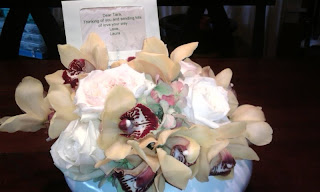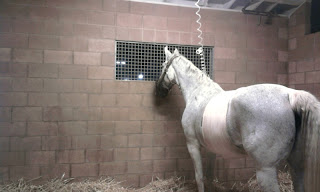



After a week off of riding due to rain, I had three great rides in a row with Mazzy on Saturday, Sunday and yesterday. She is on the upswing right now and feeling better, stronger, and much easier every time I ride her.
A glimpse into my world.... Jewelry Design, Horses, Arts and Crafts, Travel, Wine, Restaurant Reviews




Posted by Five O'Clock Somewhere at 10:39 PM 4 comments
They say some horses leave hoofprints on our hearts, I, however say only a few are actually capable of sailing away with them.





Posted by Five O'Clock Somewhere at 9:20 PM 13 comments
Labels: Kylie





Posted by Five O'Clock Somewhere at 2:47 PM 5 comments
Labels: Horses, Kylie, veterinarian

Posted by Five O'Clock Somewhere at 5:54 PM 4 comments
Labels: Horses, Kylie, veterinarian
I think I have been home for about 10 hours total, including sleep for the past 5 days. Of course, all of this has happened during the busy time at work, quarter end, so no chance for any time off there. And I still need to get Mazzy out the days my trainer doesn't ride her, so no break there, but I am still managing to make it out to the equine hospital each night, driving 125 miles a day to get it all done.
The reflux stopped, so Kylie was able to graze a little yesterday. I'm talking on grass as long as astroturf, so a very little. It went through but she has diarreah. I guess its good that at least it made it through. However, she was moved to the isolation barn because of risk of Salmonellosis. During a colic episode, your horse's immune system may become compromised and any bacteria or organism they carry in thier gut can no longer be controlled. The salmonella bacterium, in particular, which all horses carry, can flourish and cause severe diarrhea. Not sure if that is what is going on here, but if so, they don't want it to get any of the other horses to get sick.
She's looking brighter everyday. After I grazed her for a few minutes and took her for a walk, we went over to her new home in the isolation barn. I picked her out a stall that had a window so she could watch the baseball game. She was mezmorized. Her face was glued up against the window watching every play. She forgot I was there. I'm glad she has something to keep her busy.

Watching Baseball

Her view
Posted by Five O'Clock Somewhere at 9:00 AM 3 comments
Labels: Horse, Kylie, veterinarian


Posted by Five O'Clock Somewhere at 9:30 AM 3 comments
Labels: Horse, Kylie, veterinarian
Well the good news is Kylie made it through surgery. BUT she has a long, winding, very difficult road ahead of her. She got up after an hour, which the doc said was pretty normal after being in surgery for so long. He removed 95% of her colon (large intestine), which they can live without if they survive all the potential complications from surgery. I feel so awful seeing Kylie this way. Her eyes are swollen from being on her back for so long during surgery. She is still out of it, and has IVs hanging from the ceiling attached to her, huge bandages around her belly, she has a Hannible Lechter leather muzzle on so she doesn't eat her staw bedding, and she stinks almost unbearably of DMSO (smells like rotting garlic and onion). It is overwhelming to see her like this. Just a day ago I was riding and jumping her happy and free. The vet told me that heart rate (HR) at 24 hours after surgery was significantly associated with survival. Thankfully, Kylie's is in the range for survival.
The term "colic" means only "pain in the abdomen" or "pain in the belly". There are many causes for such pain, ranging from the mild and inconsequential to the life-threatening or fatal. One of the problems with equine colic is that it can be very difficult in the early stages to distinguish the mild from the potentially fatal. This is why all cases of abdominal pain should be taken seriously right from the onset. Some horses are so painful on presentation at the hospital that there is no question surgery is needed, this was our case.
Kylie had the most severe form of colic - a twisted bowel, these types of colic cause a total blockage of the intestine and require immediate surgery if the horse is to survive. Not only is gas and food material trapped inside the twisted gut, but blood supply is cut off, causing damage or death to the intestine. As the gut dies, toxins are released into the body, causing severe illness or even death. For some horses, pain medication helps keep them quiet for approximately an hour. But some horses are so painful that the drugs seem to help very little. Horses can die from this type of colic within a few hours. So thankfully my friend noticed there was a problem!!! The cause for this type of colic is poorly understood, so I have no idea why this happened to her.
The large intestine fills a significant part of the abdomen. The total length of the large intestine is about 25 feet, but it holds approximately 30 gallons of material - twice as much as the small intestine. Surprisingly, this large unwieldy structure is tethered to the body wall at only two points: at its beginning (where it joins the small intestine and caecum) and at its end (where it joins the short, narrow small colon which leads to the anus). With only two immobile points, the large intestine lies in the abdomen in a neatly-arranged double-U formation, one "U" stacked on top of the other. This arrangement entails the food making it round a number of 180 bends (known as "flexures") in the intestine. In addition to these problems the only thing that holds the colon in place is bulk. So a hungry horse without access to forage and an empty colon is a prime candidate for a twisted gut.
So many challenges lie ahead...
The first 72 hours after surgery are the most critical. This is when the intestines are trying to reorganize themselves from being manipulated, cut open, et cetera. As a result the intestines sometimes stop moving, which is very painful for the horse. Also, if the circulation to the intestines was cut off for too long, the lining of the intestines sometimes reacts by becoming inflamed, or dies, resulting in severe diarrhea. If the horse had intestine cut out, the site of reattachment may fail, causing either another blockage or rupture at the site. After surgery the horse’s immune system is compromised from stress, and infection is a concern. Laminitis, may also occur.
Posted by Five O'Clock Somewhere at 11:56 AM 5 comments
Labels: Horse, Kylie, veterinarian
I know I have been gone for a long time. It is due to a horribly long commute which is eating up all of my spare time. Commuting 17 1/2 hours a week + riding every night = no time for blogging. It actually doesn't leave much spare time for anything. No time to make jewelry either :-(. But I wanted to document this awful event I am trying to live through.

Posted by Five O'Clock Somewhere at 11:02 PM 9 comments
Labels: Horses, veterinarian




